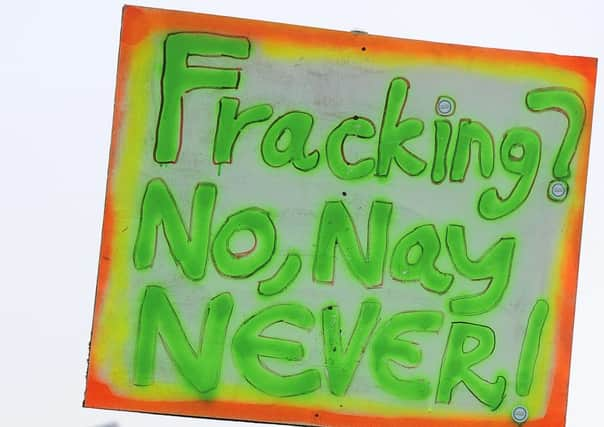Martyn McLaughlin: Time to get facts on fracking out in the open


If there is one policy area that has rivalled constitutional matters for emotive and ill-tempered debate in recent years, it is fracking. On one side, the extraction technique is regarded as a transformational economic lifeline; on the other, its opponents deem it an environmentally ruinous folly which, if approved, would destroy Scotland’s low carbon aspirations. The middle ground, where reasoned argument might be found flourishing just below the surface, is a largely untilled land.
The confirmation that Ineos expects the first shipments of shale gas to arrive at its Grangemouth petrochemical complex over the next month should spark a more enlightened discussion than has taken place to date, though it also risks obscuring it.
Advertisement
Hide AdAdvertisement
Hide AdThe company will not be breaking Scottish soil to source its shale gas ethane. Instead, it will command an eight-strong fleet of vast supertankers to transport the shipments from western Pennsylvania across the Atlantic and into the Forth. Each vessel has the capacity to carry up to 27,500 cubic metres of liquefied ethane. Cumulatively, Ineos say, its Dragon Class fleet will transport approximately 800,000 tonnes of ethane annually from the US to Grangemouth and Ineos’s ethylene cracker facility in the Norwegian port of Rafnes.
The scale of such a project should give some indication of the company’s belief that the economics of US shale gas can be exported successfully to Europe. It has invested colossal sums, around £1.5 billion, in the transcontinental operation. Around a third of that has gone directly into Grangemouth, constructing a vast storage tank, pipeline connections and a jetty facility to receive the cargoes. In the words of David Thompson, chief executive of the firm’s trading and shipping division, it is “quite simply one of the greatest engineering projects in the world”.
As the home of Telford and Watt, Scotland might have reason to question such a claim, but there can be no doubt that the ambition and commitment demonstrated is of equal value to Ineos as the revenue it will generate. It knows that once operational and running at full rate, the scheme and its methodologies will be perceived as routine.
Taking the next step – extracting gas from the carboniferous shales of the Midland Valley – represents a sizeable leap, but the greatest argument Ineos can bring to the table is a sense of normality and profitability at Grangemouth. Those two issues will be seized upon by the pro-lobby to reframe the debate among a sceptical public.
Already, the fracking information war is intensifying at pace. Only yesterday, one national newspaper gave over a full-page column to Gary Haywood, chief executive of Ineos Shale, who wrote of how “the absurdity of importing hundreds of thousands of tons of US gas when we could be producing our own should be readily apparent on many grounds”. The subtext of the piece was barely disguised; fracking is here and here to stay, so why shouldn’t Scotland embrace the industry wholeheartedly?
Environmental groups, in turn, are redoubling their efforts in research, briefing and lobbying, but one body of evidence is conspicuous by its absence. Nearly 18 months have passed since the Scottish Government imposed a moratorium on granting planning consents for fracking. It was a sensible and pragmatic move, preceding what the then energy minister Fergus Ewing described as “a national debate characterised by examining the evidence”.
A programme of consultation outlined soon afterwards promised five separate research projects designed to scrutinise a range of issues, from seismic activity and climate change through to traffic impacts and decommissioning considerations. Along with a public health impact assessment carried out by Health Protection Scotland, it spoke of a comprehensive and considered fact-finding mission. At the time, Mr Ewing said, a public consultation was likely to be launched within two months.
Regrettably, details have remained a stranger to the the public domain, save for questions over the independence of senior consultants commissioned to carry out the work. All but one of the six reports are due to be published by “summer 2016” (the government told me yesterday that “more definitive guidance” on timings would be available soon), while Mr Ewing’s promise of a public consultation will not be realised before winter.
Advertisement
Hide AdAdvertisement
Hide AdThere is a good argument that such important work must not be rushed, but equally, the protracted process has not helped those who reasonably place their trust in expert opinion rather than chief executives and campaigners. That is to say nothing of the danger of important issues being obscured or ignored if the research are published simultaneously, resulting in a data dump. By the time the public consultation begins, US sourced ethane will be coursing through the Grangemouth plant. For those who believe ethical considerations are paramount in the case against fracking, that flurry of activity will be unhelpful to their submissions; for Ineos, the prospect of the arguments focusing on the cost and principles of importing ethane will be welcome.
Yet these cannot be the chief considerations. The legitimacy of the decision on whether to allow fracking is entirely dependent on the integrity of the debate. Let us hope it improves.